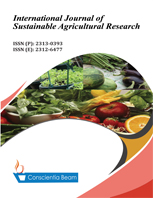Nutritional qualities and heavy metals accumulation in grains: A study on lowland irrigated rice with different fertilizer inputs and growing seasons
DOI:
https://doi.org/10.18488/ijsar.v10i3.3531Abstract
Integrated and organic nutrient management has become a focal point of current production systems seeking better perspectives on environmental friendliness. The food quality in such a scenario requires special consideration for ensuring safety during consumption. This study was conducted to understand the grain quality of the Bg300 rice variety grown under three fertilizer input systems: conventional (100% N supply with the recommended by the Department of Agriculture (DOA), integrated (50% of N provided with DOA recommended fertilizer + 25% of N supply with organic fertilizer), and 50% of N provided with organic fertilizer in dry tropical irrigated lowland systems in Sri Lanka. The grains were analyzed for proximate composition (moisture content, ash, protein, fat, fiber, and carbohydrate), micronutrients (Fe, Cu, Zn, and Mn), and heavy metals (As, Cd, and Pb). The experiment was arranged as a randomized complete block design and conducted during five seasons, from the 2018-19 wet seasons to the 2020-21 wet seasons. The highest moisture content and carbohydrate content were reported with the organic system. The ash content and protein content significantly (p<0.05) changed with the respective levels of fertilizer in the three input systems. Cadmium and arsenic micronutrients were detected below the permissible level (0.4 and 0.2 ppm), while lead was detected above the permissible level (0.2 ppm). Integrated and organic systems can be used instead of the conventional fertilizer application method without compromising the quality of the rice grain.

